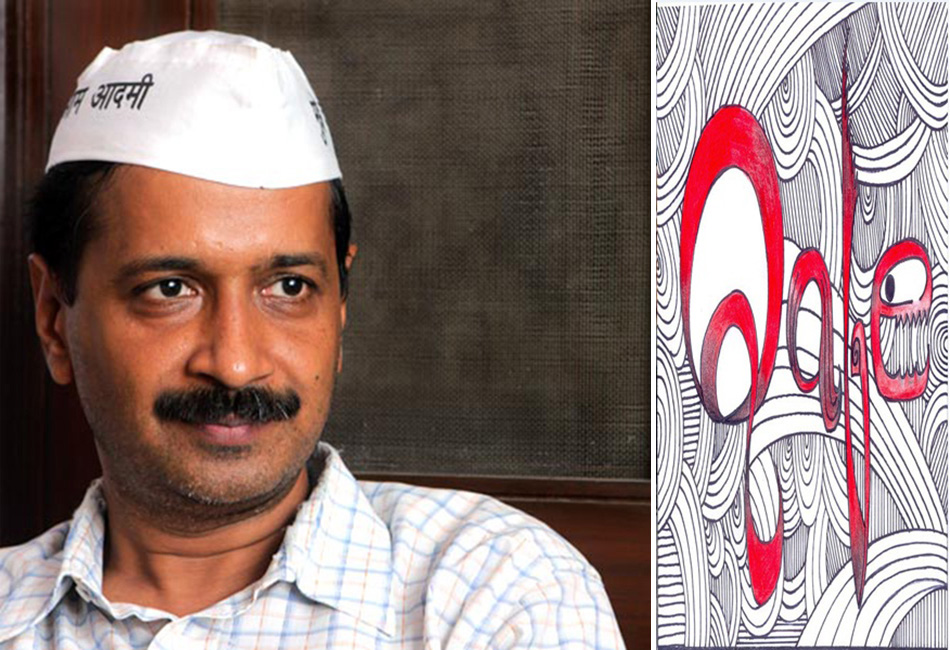The victory of the Aam Admi Party has been lauded in mainstream media even culminating in a form of cult-hero worship. Paramita Banerjee interrogates the ideology, through which the ‘auraat’ gets subsumed under the category of ‘admi’ ….
Well, that certainly is the peg on which the Aam Admi Party floated and popularised itself: transparency. And, as mentioned in an earlier piece in Qafe (‘When Pigs Fly’, 4th November, 2014), the Sanskrit term swachhwa, from which the Hindi term swachh has been derived, means transparent, lucid – much more than just the kind of cleanliness that can be achieved with material brooms – even when in the hands of the Prime Minister, his colleagues, sportspersons, film stars, media representatives and government officials. As an election symbol, it has some degree of metaphorical value implicit in it and can, therefore, be construed as sweeping out all kinds of corruption to achieve transparency in politics.
The resounding victory of the Aam Admi Party (henceforth AAP) is being lauded/ debated/ discussed/ analysed by both the media and the aam admi so to say from different angles every day. This journal has also published two articles already. But still, I cannot quite stop myself from writing this particular column. “Kejri-wall stops Modi Juggernaut” (as NDTV put it) – no doubt about that. But has there really been a paradigm shift? Is there just one paradigm shift that is needed, or are there several? Have they all been shifted?
I was struck by the cover of the AAP’s Election Manifesto for 2015; their 70 point programme for Delhi had only one man on the cover: Arvind Kejriwal. Even the BJP’s Manifesto for the 2014 Parliamentary elections did not feature Modi alone, though the campaign certainly focused almost entirely on his leadership skills and his ‘Gujarat Model’ – which conveniently pushed under the carpet several uncomfortable facts. Anyway, AAP seems not to have made any significant departure from the Indian political tradition of cult-hero worship. It is not the aam admi (the common man) on the cover of AAP’s election manifesto; it is Arvind Kejriwal: the leader, the saviour, the first among equals – as George Orwell might have implied. The rejoicing is not around a Delhi ruled by the common man for the next five years; panch saal Kejriwal (five years of Kejriwal) is the slogan everywhere.
Of course, one could argue that the first two points in the AAP Manifesto is a clear indication that Kejriwal represents the common man and only the common man – but then, this qafeteer has qualms about those two top priorities: the Jan Lokpal Bill and the Swaraj Bill. Qualms about the mechanism for selecting the Lokpal (at the centre) and the Lokayukta (at the state level) members. With all other corruption investigating agencies being merged into one having the supreme power to investigate any cases of corruption against just anyone – the Lokpal and Lokayukta members will have immense powers. That in itself is problematic, for power as a corrupting force is a proven truth. Of further discomfort is the assertion in the Bill that: “…no proceedings or decision of the Lokpal shall be liable to be challenged, reviewed, quashed or called in question in any court of ordinary Civil Jurisdiction”. The authority and responsibility of investigation, prosecution, judgment – all rolled into one? Plausible? Safe? Not quite sure, really!
Going back to the question of paradigm shift, some have also been heard/read arguing that AAP has achieved a major paradigm shift in being a young party with a young cabinet where the average age is about 40. As one of the invited participants of Barkha Dutt’s ‘We the People’ show at NDTV on 15th February, 2015, pointed out – AAP is not the first to have achieved any novelty there. The Asom Gana Parishad (better known simply as AGP) government in Assam in 1996 was also a young party with an even younger cabinet with the average age of about 30.
Let’s take a quick detour at this point into what the much hyped Gujarat Model has really yielded. The neo-liberal economic model followed by Narendra Modi’s Gujarat assumes that economic growth automatically triggers development in the social sector. Just to jog memories, Indian economist and Nobel laureate Amartya Sen and Pakistani economist Mahbub ul Haq created the Human Development Index (henceforth HDI) in 1990 – a system of measuring growth taking into account the ground realities in the social sector, as opposed to measuring growth by just the income index. The United Nations Development Programme (UNDP) adopted this and further streamlined it in 2010 by developing an inequality-adjusted HDI. Education and health, to name just two, are important indices for measuring growth as per the current HDI.
The Human Development Report released by the UPA government in March 2014 draws on the HDI of 2011 and reflects a sharp rise of 26.77% in Gujarat from 2007 – 08, though the state’s rank as ninth remains unchanged. Now, where did this remarkable improvement take place? One needs to scan with some patience to discover where the catch is: Gujarat’s income index improved by 84% as against the national average of 68%. But in the health index, Gujarat achieved just 25%, marginally better than the national average of 24% and in education the state’s achievement was a poor 43%, where the national achievement has been 62%. Must add to this that Gujarat’s sex ratio as per the 2011 Census stands at 919 females per 1000 males, where the national one stands at 940 females per 1000 males. Obviously, not all is shining in Modi’s Gujarat.
Now, how does the AAP’s 70 point programme for Delhi address these aspects of education, health and gender? Education and health definitely feature in AAP’s programme, Point 25 mentions “increased spending on education and healthcare” as one of the party’s top priority area and points 19 – 24 deal with education related matters, while points 26 and 27 relate to healthcare. What about gender? Yeah, that’s where the catch is. Of course, it has been repeated ad nauseam by AAP spokespersons that women’s safety is also a top priority area for the party, but after all – it is an Aam Admi Party, where the common man includes the common woman. No paradigm shift has certainly been achieved in the use of language. Arvind Kejriwal and company has not shown the courage of calling their party Aam Aurat Party, thereby creating a new tradition of the common woman including the common man in a remarkable departure from the sexist language where ‘man’ includes ‘woman’ (though by spelling, it is the exact opposite) and ‘he’ includes ‘she’ (again, the contrary by spelling, though). Not even an Aam Janta Party to be somewhat more inclusive in its use of language. If, for argument’s sake, one accepts that the term ‘Janta’ (people) has been much maligned by over-use in Indian politics, what about an Aam Insaan Party (Common People’s Party)? Would the AAP patriarch (who may be benevolent, by the way) argue, a la official Marxist discourse determined by a Stalinist style of functioning, that such semantic debates are pointless when more pressing issues like education, health, water and sanitation need to be addressed earnestly?
Let us not forget that Karl Marx himself had said in The Communist Manifesto that “In every proletarian home, the male worker is the bourgeois with his wife as the proletariat” – thereby indicating that such inequality also needs to be addressed beyond the overall achievement of proletarian dictatorship, if the grand dream of a free, just and equal communist world was to materialise. Kejriwal or AAP do not professedly go by the bearded Jew’s doctrines, but this is relevant in addressing whether the subsuming of women under men is merely semantic. Moreover, social research across the globe has variously established that issues of gender inequality have to be addressed simultaneously with other forms of power imbalance – not after all else has been taken care of, if social justice has to be achieved.
Even if one accepts for the time being that the debate is only at the level of semantics, there’s enough in feminist discourse to throw light on how the use of sexist language facilitates the perpetration of patriarchal power imbalances. This is not the space for elaborating on that topic, but just to drive the point home, one simple quote from Jeffrey Eugenides’ Middlesex: “Maybe the best proof that language is patriarchal is that it oversimplifies feeling.” And this qafeteer, a common woman, feels let down by the Aam Admi Party insofar as there are just six women among the 67 winners, and none in the Cabinet. By the extremely protectionist approach taken to women’s safety in its manifesto with the focus solely on increased vigilance – with no words uttered about women’s empowerment. The silence about privileging girls’ admission to schools and special drives for continuing education for girls into the secondary stage and beyond. About the health agenda where the only utterance of relevance specifically for women is about additional maternity beds in government healthcare. No paradigm shift in re-defining public health programming to look at women’s health more comprehensively beyond just reproductive and child health.
Aam admi ki takat dekho takat dekho (observe the strength of the common man) – AAP supporters are singing and dancing. Will there ever be a mainstream political party that will celebrate ‘aam aurat ki himmat’ (the courage of the common woman) – this qafeteer keeps wondering.














